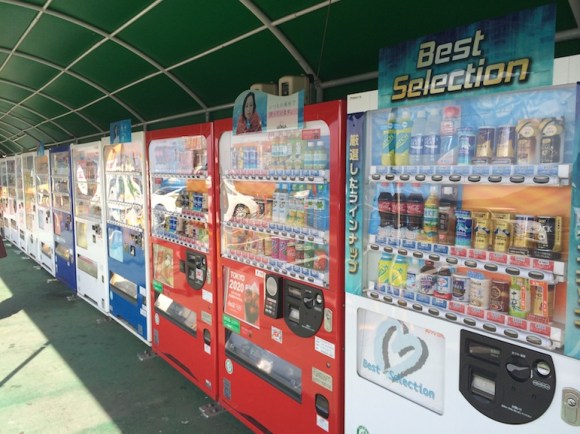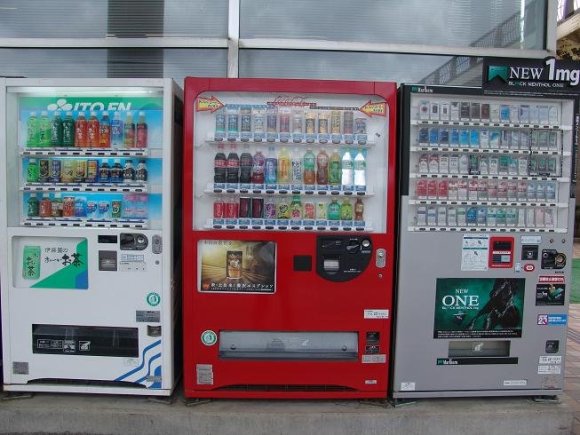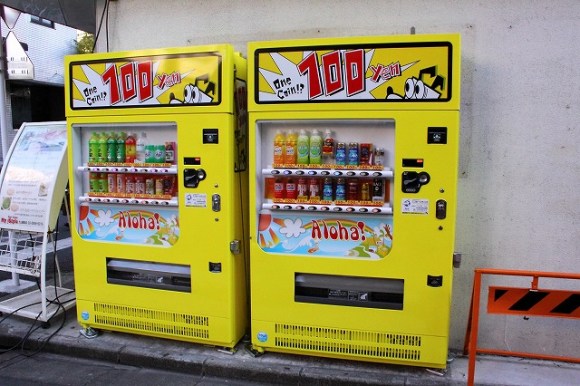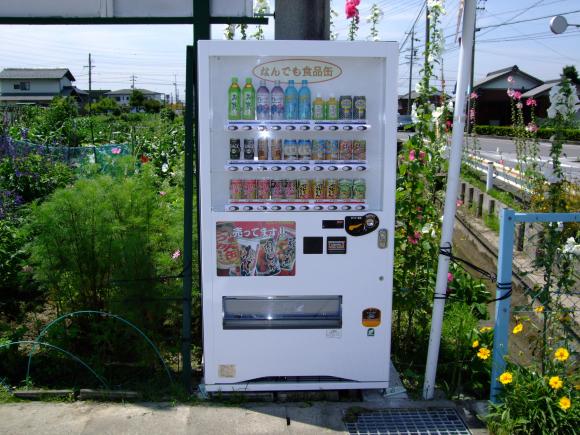Vending machines are ubiquitous in Japan. You’ll find them on most street corners, outside office blocks, lined up at bus stops, and even on the top of Mount Fuji. Prices vary, but the lowest you’ll find in Tokyo is usually the ‘one coin’ machines where everything costs just 100 yen (US$0.98). How can they sell them so cheap? Are they actually profitable? The answer is yes, and many ordinary business-minded folks are taking advantage of the opportunities they offer to put away a nice chunk of cash each month.
Owning vending machines is one of the simplest and most hands-off side businesses you could think of. All you need is somewhere to install it, and it’ll diligently work away earning money for you day and night while you do pretty much nothing. Just sticking one in front of your house is like putting a bank box out there for others to deposit money into.
Many vending machines are owned by beverage companies such as Ito En, Asahi, or Coca Cola, and landowners can enter into a contract with them to place the machine on their land, receiving either a land rental fee or a cut of the profits from drinks sold. In this case the only thing you have to worry about is the electricity bill, and otherwise it’s a pretty reliable, risk-free investment.
However, other people looking to earn a bit of extra cash are taking a more independent approach. And apparently right now is the time to start your side business as, believe it or not, the increase in consumption tax has actually been a blessing in disguise for these entrepreneurs.
Mr. C (46), who earns money from his vending machines alongside his job running a restaurant, explains the system. “There’s a method where you contract with a distributor for the beverage company, but that’s no fun because you only get around 10 yen (US$0.10) profit from each drink. What I’m doing is buying and installing ‘independent’ vending machines myself.”
- Higher tax is actually a good thing?!
Consumption tax in Japan was raised from 5 percent to 8 percent at the beginning of April, meaning that not only is everything now just that little bit more expensive, but it’s also all in awkward amounts like 687 yen meaning your pockets are always filled with annoying bits of change. However, since vending machines don’t accept 1 yen coins, beverage companies have raised prices in their machines by 10 yen, for example from 120 yen to 130. According to Mr. C, this has been favorable for independents like him. “If there’s a fixed-price company vending machine nearby, then for me to compete by selling at 100 yen means that my stuff flies off the shelves.”
- How to make it work for you
The essential things you need to consider when looking to install your first vending machine are purchasing the machine itself, purchasing the stock, and finding a place to put it.
“The main point is how cheaply you can purchase the plain white vending machines that in the industry lingo are called ‘beppin-san’ (beppin can mean a beauty, or an item of special quality). Buying one new will set you back 1.2 million yen (US$11,700), but I go around asking appliance shops if they have any good but second-hand machines from stores that have gone out of businesses and so on. Rather than the expensive slim-types, a cheaper standard type (holds 360 bottles) that is three years old can be bought for around 200,000 to 300,000 yen ($1,960-2,950), and you can use it for at least another five years.” Since they’re second-hand, sometimes these machines will still have old company logos on their sides, but once you’ve purchased one you could cover it up with your own ‘one coin’ sign.
“I buy my stock from cash wholesalers for 38 to 60 yen (US$0.37-0.59) per bottle. I choose my lineup based on an average gross profit (sales revenue minus purchase cost) of 50 yen ($0.49) per bottle. The machine runs 24 hours a day so the electricity bill is around 5,000 yen ($49) per month.”
The national average sales for a vending machine is almost 40,000 yen (US$390) per month. If it’s in a particularly good place where you can expect a consistent flow of people, such as near a station on a commuting route or by a park, then it can be as much as 500,000 yen ($4,900)!
That all sounds too good to be true – are there any pitfalls?
The most important thing you need to consider is where to place your machine, as this can be the difference between a nice wad of cash in your pocket and having to actually fork out your own hard earned money just to keep it running.
Mr. C advises that “it’s best if your own house is in one of these ‘good spots’, but if this isn’t the case then you can ask the owner of a suitable area to put it on his or her land. In these situations it’s common to pay a leasing fee to place the machine of 10,000 yen (US$98) per month, or hand over 30% of the profits. If you have three machines in a place where there are a lot of people passing by, then you can aim for a minimum income from your side business of 200,000 yen ($1,965) per month. Of course, the worst thing you can do is place your machine in a place where it can’t sell the drinks. If your monthly sales drop to 20,000 yen ($196), then rather than turning a profit you’ll be in the red due to the depreciation of the machine, the cost of buying stock, and paying for land rental and electricity usage.”
Another thing is to be careful when ordering your stock, and be aware of what will and won’t sell. Mr. C experienced this himself the hard way: “it’s also tough if you make a mistake when selecting your products. I bought some non-branded juice which seemed like a great idea because it was so cheap, but it didn’t sell at all and with it nearing its expiration date I found myself stuck with drinking this disgusting juice every day myself!”
So for anyone in Japan looking to bring in an additional cash flow, this could be your chance! I know Japan seems like it’s got plenty of vending machines already, but I’m sure there’s always room for more.
Source: Shueisha News
Header Image: My Small World
Insert Images: Yu-sa, Oyama News, Enndoukenntiku





 We try fresh orange juice squeezed for us by a vending machine in Saitama【Taste test】
We try fresh orange juice squeezed for us by a vending machine in Saitama【Taste test】 Tokyo vending machine sells beautiful shugifukuro money envelopes for wedding and other gifts
Tokyo vending machine sells beautiful shugifukuro money envelopes for wedding and other gifts Japanese stationery vending machine at Haneda Airport is a great option for last-minute souvenirs
Japanese stationery vending machine at Haneda Airport is a great option for last-minute souvenirs Japanese origami vending machine makes news around the country
Japanese origami vending machine makes news around the country Weird Japanese vending machine comes with a heartwarming twist
Weird Japanese vending machine comes with a heartwarming twist McDonald’s new Happy Meals offer up cute and practical Sanrio lifestyle goods
McDonald’s new Happy Meals offer up cute and practical Sanrio lifestyle goods More foreign tourists than ever before in history visited Japan last month
More foreign tourists than ever before in history visited Japan last month Beautiful new Final Fantasy T-shirt collection on the way from Uniqlo【Photos】
Beautiful new Final Fantasy T-shirt collection on the way from Uniqlo【Photos】 Arrest proves a common Japanese saying about apologies and police
Arrest proves a common Japanese saying about apologies and police Starbucks reopens at Shibuya Scramble Crossing with new look and design concept
Starbucks reopens at Shibuya Scramble Crossing with new look and design concept The oldest tunnel in Japan is believed to be haunted, and strange things happen when we go there
The oldest tunnel in Japan is believed to be haunted, and strange things happen when we go there Disney princesses get official manga makeovers for Manga Princess Cafe opening in Tokyo
Disney princesses get official manga makeovers for Manga Princess Cafe opening in Tokyo Beautiful Sailor Moon manhole cover coasters being given out for free by Tokyo tourist center
Beautiful Sailor Moon manhole cover coasters being given out for free by Tokyo tourist center Hey, Japanese taxi driver! Take us to your favorite restaurant in Tsuruga City!
Hey, Japanese taxi driver! Take us to your favorite restaurant in Tsuruga City! New Japanese KitKat flavour stars Sanrio characters, including Hello Kitty
New Japanese KitKat flavour stars Sanrio characters, including Hello Kitty We try out “Chan Ramen”, an underground type of ramen popular in the ramen community
We try out “Chan Ramen”, an underground type of ramen popular in the ramen community Foreign English teachers in Japan pick their favorite Japanese-language phrases【Survey】
Foreign English teachers in Japan pick their favorite Japanese-language phrases【Survey】 Is the new Shinkansen Train Desk ticket worth it?
Is the new Shinkansen Train Desk ticket worth it? There’s a park inside Japan where you can also see Japan inside the park
There’s a park inside Japan where you can also see Japan inside the park Japanese convenience store packs a whole bento into an onigiri rice ball
Japanese convenience store packs a whole bento into an onigiri rice ball Studio Ghibli releases Kiki’s Delivery Service chocolate cake pouches in Japan
Studio Ghibli releases Kiki’s Delivery Service chocolate cake pouches in Japan Japan’s bone-breaking and record-breaking roller coaster is permanently shutting down
Japan’s bone-breaking and record-breaking roller coaster is permanently shutting down New definition of “Japanese whiskey” goes into effect to prevent fakes from fooling overseas buyers
New definition of “Japanese whiskey” goes into effect to prevent fakes from fooling overseas buyers Foreign passenger shoves conductor on one of the last full runs for Japan’s Thunderbird train
Foreign passenger shoves conductor on one of the last full runs for Japan’s Thunderbird train Our Japanese reporter visits Costco in the U.S., finds super American and very Japanese things
Our Japanese reporter visits Costco in the U.S., finds super American and very Japanese things Kyoto bans tourists from geisha alleys in Gion, with fines for those who don’t follow rules
Kyoto bans tourists from geisha alleys in Gion, with fines for those who don’t follow rules Studio Ghibli unveils Mother’s Day gift set that captures the love in My Neighbour Totoro
Studio Ghibli unveils Mother’s Day gift set that captures the love in My Neighbour Totoro Domino’s Japan now sells…pizza ears?
Domino’s Japan now sells…pizza ears? Sales of Japan’s most convenient train ticket/shopping payment cards suspended indefinitely
Sales of Japan’s most convenient train ticket/shopping payment cards suspended indefinitely Sold-out Studio Ghibli desktop humidifiers are back so Totoro can help you through the dry season
Sold-out Studio Ghibli desktop humidifiers are back so Totoro can help you through the dry season Japanese government to make first change to romanization spelling rules since the 1950s
Japanese government to make first change to romanization spelling rules since the 1950s Ghibli founders Toshio Suzuki and Hayao Miyazaki contribute to Japanese whisky Totoro label design
Ghibli founders Toshio Suzuki and Hayao Miyazaki contribute to Japanese whisky Totoro label design Doraemon found buried at sea as scene from 1993 anime becomes real life【Photos】
Doraemon found buried at sea as scene from 1993 anime becomes real life【Photos】 Tokyo’s most famous Starbucks is closed
Tokyo’s most famous Starbucks is closed One Piece characters’ nationalities revealed, but fans have mixed opinions
One Piece characters’ nationalities revealed, but fans have mixed opinions We asked a Uniqlo employee what four things we should buy and their suggestions didn’t disappoint
We asked a Uniqlo employee what four things we should buy and their suggestions didn’t disappoint Princesses, fruits, and blacksmiths: Study reveals the 30 most unusual family names in Japan
Princesses, fruits, and blacksmiths: Study reveals the 30 most unusual family names in Japan Studio Ghibli’s new desktop Howl’s Moving Castle will take your stationery on an adventure
Studio Ghibli’s new desktop Howl’s Moving Castle will take your stationery on an adventure Japan’s newest vending machine absorbs CO2 from the environment
Japan’s newest vending machine absorbs CO2 from the environment Sushi from a vending machine — would you try it? Mr. Sato did
Sushi from a vending machine — would you try it? Mr. Sato did Get a soda and good karma with this donation-accepting vending machine
Get a soda and good karma with this donation-accepting vending machine Japan’s new ramen vending machine cooks noodles in just 90 seconds, serves four different types
Japan’s new ramen vending machine cooks noodles in just 90 seconds, serves four different types Send a free drink to a friend with Japan’s newest coinless vending machines【Video】
Send a free drink to a friend with Japan’s newest coinless vending machines【Video】 Japanese drink vending machine capsule toys: A must-have for recreating Japan in miniature
Japanese drink vending machine capsule toys: A must-have for recreating Japan in miniature Japan’s most mysterious vending machine sells fukubako, boxes filled with…something【Photos】
Japan’s most mysterious vending machine sells fukubako, boxes filled with…something【Photos】 We buy oysters from a Japanese vending machine
We buy oysters from a Japanese vending machine We hope you’re not thirsty — Tokyo shuts down its vending machines for U.S. president’s visit
We hope you’re not thirsty — Tokyo shuts down its vending machines for U.S. president’s visit Vending machine makes commuters smile at Japanese train station
Vending machine makes commuters smile at Japanese train station Three things we loved about Fujiya’s frozen sweets vending machine in Tokyo
Three things we loved about Fujiya’s frozen sweets vending machine in Tokyo Creative problem solving: Vending machine dispenses cans with 5 yen coins taped to them
Creative problem solving: Vending machine dispenses cans with 5 yen coins taped to them Oh, crepe! We discover a pastry vending machine at the airport
Oh, crepe! We discover a pastry vending machine at the airport Tokyo gets its first subway station ramen vending machine
Tokyo gets its first subway station ramen vending machine First-ever foot-operated vending machine appears in Japan during pandemic
First-ever foot-operated vending machine appears in Japan during pandemic Bottles containing flying fish now available from Japanese vending machines in Tokyo
Bottles containing flying fish now available from Japanese vending machines in Tokyo
Leave a Reply